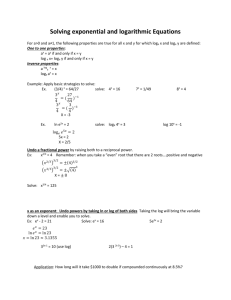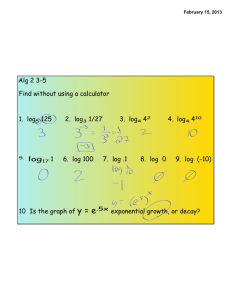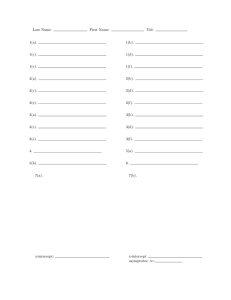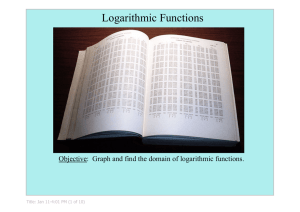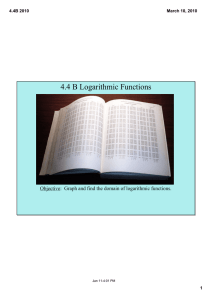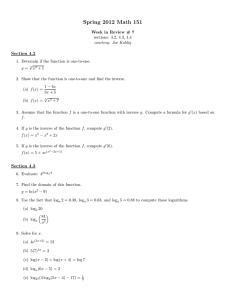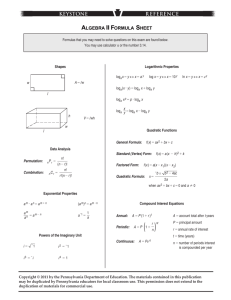Midterm 3. Name: CLOSED
advertisement
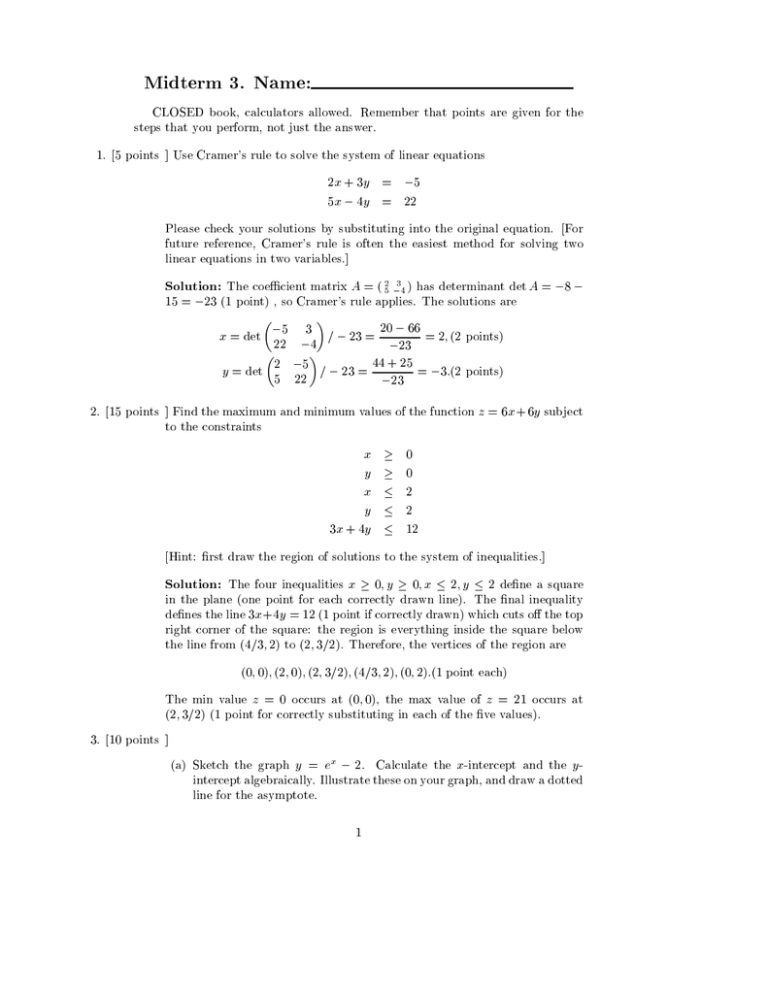
Midterm 3. Name: CLOSED book, calculators allowed. Remember that points are given for the steps that you perform, not just the answer. 1. [5 points ] Use Cramer's rule to solve the system of linear equations 2x + 3y = 5 5x 4y = 22 Please check your solutions by substituting into the original equation. [For future reference, Cramer's rule is often the easiest method for solving two linear equations in two variables.] The coeÆcient matrix A = ( 25 34 ) has determinant det A = 8 15 = 23 (1 point) , so Cramer's rule applies. The solutions are Solution: 20 66 5 3 = 23 = = 2; (2 points) 22 4 23 44 + 25 2 5 y = det = 23 = = 3:(2 points) 5 22 23 x = det 2. [15 points ] Find the maximum and minimum values of the function z = 6x + 6y subject to the constraints x y x y 3x + 4y 0 0 2 2 12 [Hint: rst draw the region of solutions to the system of inequalities.] Solution: The four inequalities x 0; y 0; x 2; y 2 dene a square in the plane (one point for each correctly drawn line). The nal inequality denes the line 3x +4y = 12 (1 point if correctly drawn) which cuts o the top right corner of the square: the region is everything inside the square below the line from (4=3; 2) to (2; 3=2). Therefore, the vertices of the region are (0; 0); (2; 0); (2; 3=2); (4=3; 2); (0; 2):(1 point each) The min value z = 0 occurs at (0; 0), the max value of z = 21 occurs at (2; 3=2) (1 point for correctly substituting in each of the ve values). 3. [10 points ] (a) Sketch the graph y = ex 2. Calculate the x-intercept and the y intercept algebraically. Illustrate these on your graph, and draw a dotted line for the asymptote. 1 First draw the graph y = ex , then shift down by 2. The horizontal asymptote is now y = 2 (1 point), the x-intercept is the solution to 0 = ex 2, hence x = ln(2) (2 points), and the y -intercept is 0 y = e 2 = 1 (1 point). (b) Sketch the graph y = ln(x + 2). Calculate the x- and y -intercepts algebraically and illustrate these on your graph. Also, draw a dotted line for the asymptote. Solution: First draw the graph y = ln(x), then shift to the left by 2. The vertical asymptote is now x = 2 (1 point) the x-intercept is the solution to 0 = ln(x + 2), hence x = 1 (2 points), and the y -intercept is y = ln(0 + 2) = ln 2 (1 point). (c) In one sentence, describe the relation between these two graphs? (e.g., how do you obtain one from the other?) Solution: They are inverse to each other, so one is obtained from the other by reecting in the line y = x (2 points). Solution: 4. [10 points ] The half-life of radioactive uranium II is 250,000 years. (a) If you currently have 10g of radioactive uranium II, how much will remain 5000 years from now? The formula is y = ae bt , where y denotes the amount of uranium at time t. We know that a = 10. The half-life always gives the value of b as follows: half the current amount of uranium is 5g, so Solution: 5 = 10e b250;000 (1 point) b250;000 1=2 = e ln(1=2) = b 250; 000 1 ln(1=2): (3 points) so b = 250; 000 Now we know a and b, we can answer the question. When t = 5000 = 10e(1=250;000)ln(1=2)5000 = 9:862 approx y (2 points): (b) How much time will have passed until only 2.5g remain? Solution: Solve for the value of t in the equation 2:5 = 10e(1=250;000)ln(1=2)t 1=4 = e(1=250;000)ln(1=2)t ln(1=4) = (1=250; 000) ln(1=2)t: (2 points) Therefore t = 250; 000 ln(1=4)= ln(1=2) = 250; 000 ln(4)= ln(2) = 500; 000:(2 pts) This makes sense because it takes 250,000 years to reduce 10g to half that amount, namely 5g. Then to reduce by half again to 2.5g it should take another 250,000 years. 2 5. [10 points ] Circle T or F according to whether you think the statement is True or False: (2 points each. The nal true/false question cannot be wrong. I know that I said you'd lose the points if you wrote true then failed on the nal question, but I liked the optimism of some members of the class so much that I couldn't bring myself to penalise them). 271; 801 F e = . 99; 990 F loga (0) = 1. 0 3 B B3 1 =B B @ 2 0 0 6 0 3 0 4 0 0 2 0 1 1 4 1 1 1 5 0C C 0C C has an inverse. 0A 0 F The matrix A F 3 ? I know how to prove that loga (uv ) = loga (u) + loga (v ). log2 (x + 3) = ln 8(x + 3) . ln 2 Feel free to use the back of this page for your working. Extra credit. [5 points] If you answered `true' to the nal true/false question, write a proof of the statement loga (uv ) = loga (u) + loga (v ) below. If you answered `false', you should leave this space blank. (Note that if you begin a proof incorrectly then it necessarily follows that everything that follows is irrelevant. This means that if you don't begin correctly, you will not receive any marks. Seems harsh I agree, that's why it's extra credit). Set Solution: y1 = loga (uv ) y2 = loga (u) These values means that ay1 = uv y1 a a y2 =u y3 = loga (v ): y3 a = v . Hence = uv = ay2 ay3 = ay2 +y3 Now apply loga to both sides to conclude that y1 = y2 + y3 as required. 3

